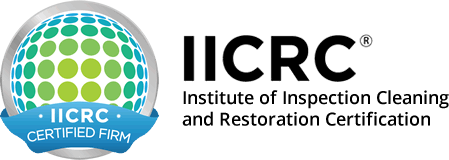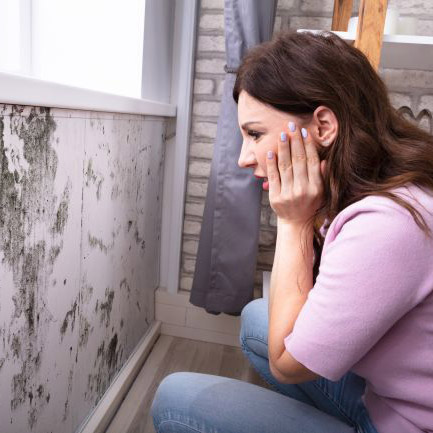Mold Inspection & Testing Specialist in Phoenix
If you have visible signs of mold or are concerned that black mold may exist in your home, we advise that you give us a call immediately.
Contrary to popular belief, you can’t simply rub bleach on an affected area to eliminate mold! We recommend that you let one of our certified technicians inspect the area in question before you attempt to remove it yourself.
Arizona Hydro-Pro is certified by the Institute of Inspection Cleaning and Restoration Certification (IICRC) in Applied Microbial Remediation and is certified in the use of Serum 1000, the most advanced technology in mold remediation.
Frequently Asked Questions About Mold Testing & Remediation
If after reviewing this FAQ section you still have any questions, please contact us. We’ll be happy to answer any questions you might have about the mold remediation process.
What is Mold?
Most people think that mold is a slimy, blackish-green discoloration found on carpeting, baseboards, or wallpaper that can be found only in dirty, unkempt homes or apartments. The truth is mold and spores can flourish in sparkling clean environments as well.
Molds are microscopic organisms found virtually everywhere outdoors. No one really knows how many species of mold exist but estimates range from tens of thousands to hundreds of thousands. Spore production is characteristic of molds in general to reproduce.
A spore is a small reproductive body that is capable of growing into a new organism, producing bacteria, fungi, and algae. Most spores are filamentous (threadlike) organisms so small that 250,000 of them fit on the head of a pin. They stay airborne indefinitely, drifting from one room to the next, landing on food, clothing, appliances, tabletops, carpeting and furniture, walls, and woodwork. Any wet, damp, or humid surface becomes a breeding ground for mold colonies and more spores.
Where can Mold be Found?
There are many places where mold can exist in your home or property. Mold and mildew can be found inside your sink, dishwasher cabinets, bathrooms, and laundry areas. There is an 86% chance of mold growing somewhere in or on your refrigerator. It’s nestled into the microscopic crevices of clothing, furniture fabric, and in your carpeting.
There is little doubt that mold spores exist in your heating and air conditioner system duct. AC units can continually disperse spores throughout the home or building looking for a place to plant themselves.
It can be found in your window sills, basement, crawl space, attic, office desk, indoor plants, kitchen counter space, on the TV, in your fireplace, and countless other places.
How do I Detect Mold?
You probably already have two effective mold detectors; your eyes and nose. If a blackish, grayish, or greenish discoloration appears, especially if the location is or was damp, it is almost certainly mold. You may not know what type it is or how extensive the problem may be, but you do know a mold problem exists and it won’t just go away by itself!
Some problems are not always visually obvious, but there are other warning signs to help detect mold. If a building smells dank and musty, there is probably mold somewhere. If you find yourself clearing your throat a lot or having pet-like allergies without any pets, chances are you’re experiencing mold. If you feel sick at home or work but you feel fine a few hours after you leave the environment, there is probably mold.
The presence of mold, water damage, or musty odors should be addressed immediately. In all instances, any source of water must be stopped and the extent of water damage determined. Water-damaged materials should be dried and repaired.
Early warning signs of mold are easily overlooked due to a general lack of knowledge identifying mold.
The most dangerous mold is the mold you can’t see simply because it often goes undetected so long that it becomes a significant problem. Visual signs of mold are often an indication of a much bigger problem. For example, mold on a wall can sometimes be the result of mold inside the wall trying to grow it’s way out. That’s why it keeps coming back in spite of the most rigorous cleaning efforts.
If I Detect Mold in my Home, what Should I do?
If you have a concern about indoor mold exposure or are in question about a possible mold colonization problem, Arizona Hydro-Pro is equipped to evaluate and assess your individual conditions. Our certified toxic mold inspectors (IHI Environmental) can conduct mold sampling and test to give you a comparative baseline analysis for an accurate snapshot of what is in the air you breathe. Call us today for a Mold Inspection at (602) 242-1120.
I’ve Been Exposed to Mold, is my Health at Risk?
The above incidences could be everyday, ordinary “low-risk” occurrences of mold – or not. Each person has their own level of tolerance to the mycotoxins (poisons) emitted by mold. Individuals with higher levels of tolerance to mycotoxins can eventually become sensitized to these poisons from prolonged exposures.
“Higher risk” mold conditions are easily recognized by the sudden appearance of emerging mold. Another unmistakable evidence of this kind of mold problem is the presence of pungent mildew or musty odor, even when mold is not visually evident. The faintest whiff of this odor should immediately prompt one’s concern about mold exposure. Now it’s time to take quick action to identify and correct the mold. Our mold consultants are prepared to assist you in necessary planning and cost-effective corrective actions to take.
Some molds have been more closely associated with specific health problems. One example is Stachybotrys chartarum, a greenish-black mold often referred to as “toxic mold”. It grows on material with high cellulose content (e.g. drywall, wood, paper, dust). Stachybotrys becomes a problem when it emits mycotoxins capable of producing toxic effects in humans and animals. Many Aspergillus species of molds also produce mycotoxins.
Some molds release volatile compounds into the air, producing an unpleasant odor. Scientists label these compounds “microbial volatile organic compounds” or “MVOCs” (Moisture Remediation in Schools and Commercial Buildings, Environmental Protection Agency, March 2001). Exposure to MVOCs has been associated with headaches, dizziness, and fatigue.
Obvious Signs of Mold
Dark stains on stucco are often an indication of dampness and mold caused by excessive exposure to water. Concrete absorbs and holds water. Porous materials fixed to wet concrete will deteriorate.
Water stains and rusty nails in the tack strip are a sure sign of a water intrusion problem. Water may have penetrated the carpet and pad, dripped down the interior wall, or entered from another room or even outdoors.
Hidden Signs of Mold
Another image of mold growing behind wall paper, It is possible to create potential mold problems when applying wallpaper with mix-it-yourself glue that is applied too wet.
The top half of this image is a bathtub and shower tiles. A musty odor, reoccurring black lines in the grout, and high moisture readings warranted removing the tile. As suspected, the walls behind the tiles were full of black mold.
Closer inspection revealed the rubber water seal on the shower door came loose. The owner tried to glue it back on. When that didn’t work, he decided to fill the opening with silicone caulk.
How Much is Mold Inspection or Remediation Going to Cost?
Once you make the call to Arizona Hydro-Pro to come out and survey the area in question, you should then contact your insurance agent to see if your policy covers mold testing or mold remediation. In most cases, your insurance agent will advise you of the procedure to follow when obtaining an estimate for mold issues. These estimates are not free, but fair and reasonably priced.
In most cases, you will only be responsible to pay an out-of-pocket fee that is subject to your insurance deductible. Again, check with your agent if you are making a claim to cover this service.
If you have any questions about mold remediation, please contact our office and we’ll be happy to assist you.



